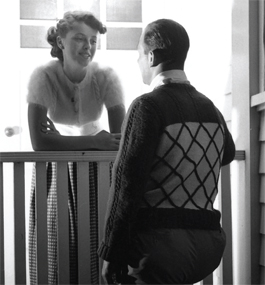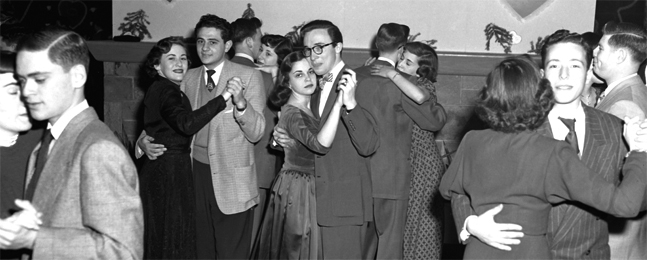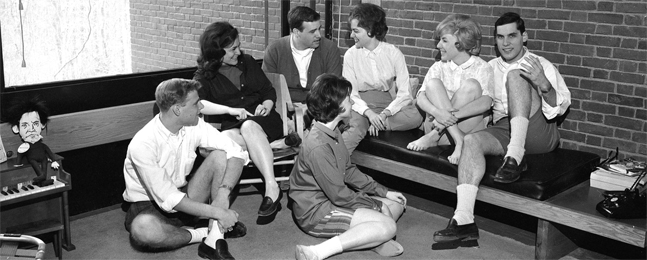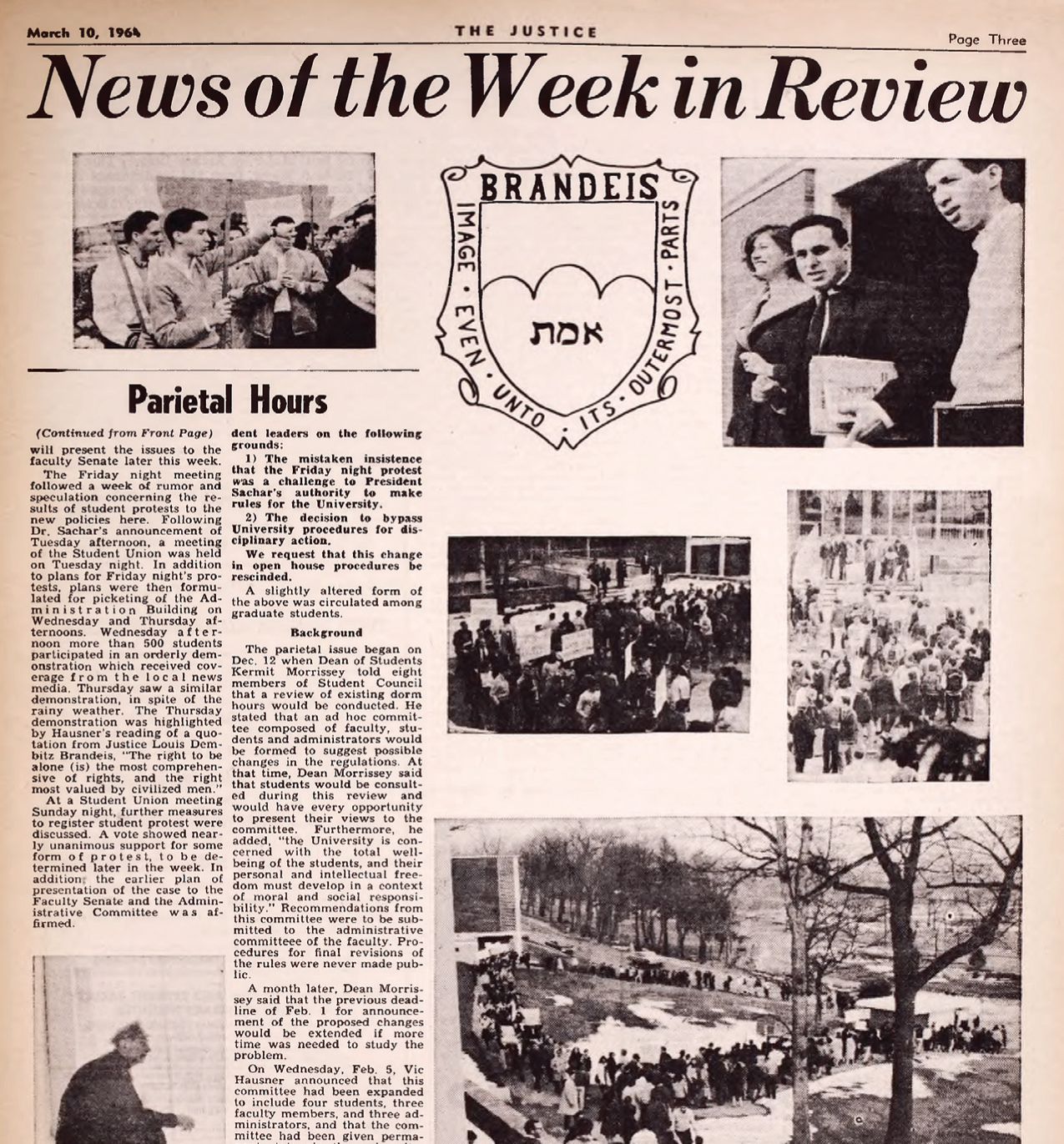Rules of Engagement
Whether sex is verboten, a cause célèbre or just another extracurricular, the history of parietals shows that college students will always find a way to get their ya-yas out.

SEPARATION ANXIETY: A chat on the Smith Hall patio, 1952.
by Laura Gardner, P’12
“Women students may not receive men, nor men students receive women, in their dormitory rooms. This applies to mothers, fathers, sisters, brothers and other relatives.”
— Brandeis freshman handbook, 1951-52
Few pastimes rival the abiding popularity of collegiate sex. Goldfish swallowing, panty raids, phone-booth stuffing and streaking have all had their day on the college quad. But campus sex is here to stay, and higher education has come to terms with that.
Like most universities today, Brandeis allows men and women living in dorms to share floors, rooms, bathrooms and beds. Most of the university’s campus housing is gender-neutral. Couples, whatever their gender identification, can opt to room together (though this rarely happens). Single-sex dorms have given way to a few scattered single-sex floors.
The rules governing socializing between the sexes in dorms, known at Brandeis and on many other campuses as “parietals” — from the Latin word for “wall” — have gone the way of the typewriter. Ask a current student what “parietals” means and, more likely than not, you will get a puzzled look.
Yet these rules were universal on college campuses in the 1950s and 1960s — a reflection of the buttoned-down mores of midcentury America. In Brandeis’ early days, female students were “gals” or “girls” who needed 24/7 supervision. Male students, far less restricted, were supposed to help the women follow the rules.
That kind of smothering paternalism, which in large part defined the 1950s, had by the mid-1960s become a flash point between the generations. At Brandeis, tightening parietals would eventually spark a showdown between students and the administration over the larger issue of in loco parentis.
But until then, the university’s attempted full nelson on the undergraduate sex drive was either — depending on whom you ask — suffocating, a mild inconvenience or just plain irrelevant.
Discretion is all
When Mike Uhlberg ’55 arrived on campus, the aspiring football star probably didn’t spend much time thumbing through his freshman handbook. If he had, he would have discovered a wealth of rules aimed at thwarting even the most hormone-crazed freshman’s attempts at romance.
The handbook dictated student decorum on and off campus. Women were subject to stricter curfews, sign-outs, penalties and travel restrictions, including a rule against leaving campus alone after 7 p.m. A particularly quaint regulation barred fathers and brothers from women’s dorms — unless they were carrying luggage at the beginning or end of a semester, and then only following a warning shout (“Man on the hall!”).
Socializing between the sexes in the dorms was limited to a few hours daily in the common rooms of Smith, Founders and the Ridgewood Cottages. Smoking, on the other hand, was permitted almost everywhere on campus.
Any student who, after scouring pages of small-font directives, suffered lingering confusion over what constituted proper conduct needed only to consult Rule 22, the handbook’s über edict: “Brandeis students should never display themselves in an unfavorable light either on or off campus, by excessive drinking, display of affection, brawling, improper language, etc. In short, BE DISCREET!”

EMBRACEABLE: Dancing at a Valentine's Day charity fundraiser, 1951.
page 2 of 4
When Uhlberg and fellow football player Bill McKenna ’55 met on campus as freshmen, they knew what discretion demanded: an automobile. A shrewd negotiator, Uhlberg managed to secure a beat-up 1937 Buick with a $35 down payment and the promise of paying another $35 by June.
“There was not much sex going on unless you had a car,” recalls Uhlberg, who remained close friends with McKenna, Brandeis’ first All-American, until McKenna’s death in 2012. “You could do anything with a car. The lucky ones had a brand-new one and, even more important, money for gas.”
Though carless, Phylis Acker ’52 managed to enjoy her first semester, too. “We came into Smith Hall thinking the housekeeper was a proctor,” she says. “Then we discovered we had no proctor, and all hell broke loose. The boys came and went, and we did whatever we wanted for a couple of months.” When a proctor finally showed up well into the fall semester, the curfews put into place were often violated.
At the end of her junior year, Phylis married Sandy Acker ’52, and the couple moved into a Brookline apartment. Phylis says she found out years later that her husband offered to let student couples use the newlyweds’ apartment when they were away. “Brandeis attracted students who were bright and independent, and not that willing to adhere to strict rules,” she explains.
This did not prevent the university from trying to set limits. The 1956-57 freshman handbook devoted an entire section to “girls’ rules”: “Probably the most confusing thing our poor little freshman gal will run into are the rules and regulations … which are the bane of the existence of every co-ed on campus.” The handbook drove the point home with a fictional character who soon realizes the necessity of “having someone watch over her.”
Students, for their part, devised the usual workarounds, Uhlberg says. Before his Buick stopped running sophomore year, the football player and his girlfriend regularly visited the Waltham home of a fellow classmate to “study hard.” Situated near the B&M Railroad tracks, the Central Street home offered the perfect cover for “studying” whenever the train roared past.
On campus, privacy was difficult to come by. “If a girlfriend was in a guy’s dorm, the roommate would end up sitting in the hall,” says Anne Hort ’67. “Some people sat in the hallway a good part of Friday and Saturday nights, and Sunday afternoon.”
Like every generation, “Brandeis students believed they invented sex and their parents were puritanical,” says Hort, who secretly eloped with her husband, Robert Hort ’67, during their junior year.
Of course, where there is illicit love, a bad case of poison ivy can’t be far behind. Uhlberg remembers a football player who made a secret love nest near the water tower on campus. “He would never tell us where it was, but one day he and a cheerleader walked into the dining hall separately, each with the most horrible case of poison ivy you can imagine. So the rest of us stopped looking for that idyllic spot.”
Far more sex, former students say, took place in students’ minds than in dorm rooms, cars or urushiol-laden woods. “The campus was simmering, but it wasn’t sexually rampant — certainly not like college campuses are today,” asserts Acker.

ALONE TOGETHER: Hanging out in a women's dorm, 1964.
page 3 of 4
A perfect storm
By the 1960s, rules started to loosen, in step with the changing social culture. The 1960-61 student handbook allowed men and women to visit each other in their room as part of an “open house” policy. For women, that meant men could visit on Sundays from 2-5 p.m., provided a resident counselor or assistant was nearby.
The following academic year, women were granted an additional 30 minutes to socialize in their room with men. Men were already allowed to have women in their room for much longer hours over weekends and holidays. Rule 22, however, remained in effect.
Before David Gerstel ’68 headed to Brandeis, leaving behind the Southern town where he spent most of his childhood and teen years, he had walked picket lines protesting Jim Crow practices and lived on his own in Europe. He was used to regulating his own life. After arriving at Brandeis, he recalls, “my freedom was reduced by a wide margin — and freedom was the big issue for me.”
In December of his freshman year, the elements of a perfect storm aligned when the administration, “concerned about the permissiveness of campus life,” announced in The Justice it planned to undertake a “general reappraisal of parietal rules … in American higher educational institutions,” apparently to find ways to curtail students’ growing eagerness for self-determination.
A Justice editorial responded: “As long as this university compels its student body to live on campus, it has an obligation to make great concessions to self-government. … This, and not the undergraduate libido, is the fundamental residential problem here.”
“Our class,” says Gerstel, “was riding a wave of anti-authoritarianism,” exemplified by the way students looked. Button-down shirts and polished loafers were giving way to army fatigue jackets and sneakers. Beehive hairdos came down; crew cuts grew to mop tops.
“The students wanted freedom, and the administration didn’t want to let go of control,” Gerstel says. “Our protest was really about in loco parentis — did the administration have the right to regulate our personal lives.”
Over the next several months, a committee of students, faculty and administrators examined parietals in the larger context of the campus environment. Then, in early March 1964, founding Brandeis president Abram Sachar “decreed that henceforth, when students entertained members of the opposite sex in their rooms, the doors must be ajar,” The Justice wrote.
As Anne Hort recalls, Sachar’s edict caused “an enormous uproar” on campus, with students complaining, “Next they’ll be telling us we have to keep one foot on the floor.”

SEEDS OF CHANGE: The March 10, 1964, issue of The Justice covered the student protests prompted by Sachar's open-door edict.
page 4 of 4
“The rules had been relatively liberal for the time, and then hard rules were imposed,” remembers Steven Kramer ’67.
Gerstel and other like-minded students responded to Sachar’s decision by organizing a student strike that canceled classes for several days. About a week later, as students prepared to “test” the open-door policy across campus — by inviting visitors to their dorm room and closing the door — Sachar threatened to expel “up to 150 participants in any mass defiance,” The Justice reported.
The protest fizzled. “We were thoroughly beaten,” wrote an undergraduate in Brandeis ’66, a student publication. Other students, however, felt that even though the protest was forced underground, it had succeeded. “Parietals were done,” says Gerstel. “Enforcement was left to grad students who served as dorm counselors, and they backed off. On my hall, a group of us cornered our counselor and let him know he’d better not even think about enforcing the open-door policy. He agreed.”
The parietal protest of 1964 may even have been a useful warm-up for the emerging anti-war movement. “The protest taught us we could effectively organize,” says Gerstel. “At its serious core, it was one of the beginnings of the movement that so reconfigured the American cultural and political landscape in the ’60s.”
By the 1967-68 academic year, the student handbook advised undergraduates not to take “lightly” the privilege of unchaperoned entertaining during open-house hours. For another few years, the official rule was that doors had to remain ajar, though whether the rule was enforced is another matter.
Soon, by the beginning of the 1970s, parietal rules had been mostly reduced to a limp admonition in the student handbook: “The university … will not condone illicit sexual behavior.”
How students expressed themselves sexually would continue to expand at college, as in the culture at large. By 1975, the Brandeis student handbook, now called a “Survival Kit,” included mention of the student organization B.A.G.E.L. — Brandeis Advocates of Gay Equality and Liberation.
Fast-forward to contemporary college life, with almost no segregation by gender or sexual identity, and you can’t help but wonder whether separating the sexes decades ago prevented or promoted sexual activity.
One thing seems true: Where campus sex is concerned, the more things change, the more they stay the same.
